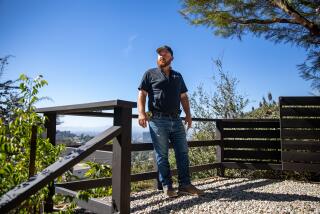Catalina exhibit illuminates a dark episode in island’s past
- Share via
The Catalina Island Museum has opened a window into a dark period of life on the island with an exhibition devoted to a pseudoscientist who looted Native American graves for profit eight decades ago.
“The Strange and Mysterious Case of Dr. Glidden,” which opened over the weekend, examines the life and times of Ralph Glidden, a hucksterish entrepreneur who in the 1920s and ‘30s excavated bones and relics from Tongva Indian burial grounds for sale and trade. He also presided over an “Indian museum” literally made of bones and situated on a hill overlooking Avalon harbor.
News articles from the 1920s written by Glidden’s publicist describe his “Indian museum” as a “unique and weirdly spectacular institution,” with shoulder-blade cornices and windows edged with toe, ankle, wrist and finger bones. Leg and arm bones served as brackets for shelves lined with skulls. Ceiling panels were decorated with human vertebra and rosettes of shoulder blades.
FOR THE RECORD:
Catalina Island Museum exhibit: In the May 13 LATExtra section, an article about a Catalina Island Museum exhibition devoted to Ralph Glidden, who looted Native American graves for profit eight decades ago, said that hundreds of skeletons, skulls and thousands of teeth he unearthed were moved to UCLA. The remains are being housed there only temporarily until arrangements are made for repatriation elsewhere.
The Catalina Island Museum’s look back at Glidden is rooted in a discovery last year. Curator John Boraggina chanced upon boxes of Glidden’s journals, ledgers, letters and photographs while searching a musty backroom for items for an exhibit of the World War II era.
More than a year later, the museum has mounted what Executive Director Michael De Marsche calls “a disturbing and troubling exhibition” about Glidden’s work. Holocaust museums examine “similar issues: the genocide of a people, the desecration of their graves and the lack of respect for the sacredness of their remains,” De Marsche said.
An introduction in the entry corridor sets the scene for visitors. “Any evaluation of the life and work of Ralph Glidden must contend not only with his disregard for the sanctity of human remains, but the near permanent damage he inflicted on research into Native American life on Catalina Island,” it reads in part.
Glidden presented himself as “Dr. Glidden” and he old many of the skeletal remains and artifacts he unearthed to prestigious institutions. He longed to churn up evidence of a mythical prehistoric race of giant fair-skinned blue-eyed Native Americans he believed once inhabited the Channel Islands, including Catalina, 26 miles off the coast.
In 1930, Glidden announced that he had discovered a 138-pound soapstone urn that contained the skeleton of a young “royal princess” crouched in an upright position with her fingers clenched over the rim. The urn, he said, was surrounded by the skeletons of 64 children buried in tiers four deep. About five feet below the children, Glidden said, was the skeleton of a man 7 feet, 8 inches tall, with a spear blade embedded in his left side.
There are no known photographs of those skeletons being unearthed. But the urn became an attraction at Glidden’s museum, which closed in 1950.
After Glidden’s death in 1968, the Wrigley family, of chewing gum fame, bought his collection for $5,000 and then donated it to the Catalina Island Museum. The artifacts — jugs, bowls, baskets, beads, amulets, rings, shell ornaments, spears, grinding stones, cutting tools and arrowheads — remain stored under lock and key. Hundreds of skeletons, skulls and thousands of teeth were moved to UCLA.
Wendy Teeter, curator of archaeology at UCLA’s Fowler Museum, said the exhibit presents “an opportunity to discuss what these kinds of collectors were doing across the country and to share some of the pain that Native American communities have been feeling all along.”
The exhibition includes a documentary film featuring recent interviews with Catalina residents who still recall paying the man whom some knew as “Uncle Ralph” 35 cents to look inside his “museum.”
More to Read
Sign up for Essential California
The most important California stories and recommendations in your inbox every morning.
You may occasionally receive promotional content from the Los Angeles Times.











